New Insights into Earthquake Light: Rayleigh Scattering as the Source of Blue Hue and a Novel Co-Seismic Cloud Phenomenon
Abstract
1. Introduction
1.1. Previous Earthquake Light Study
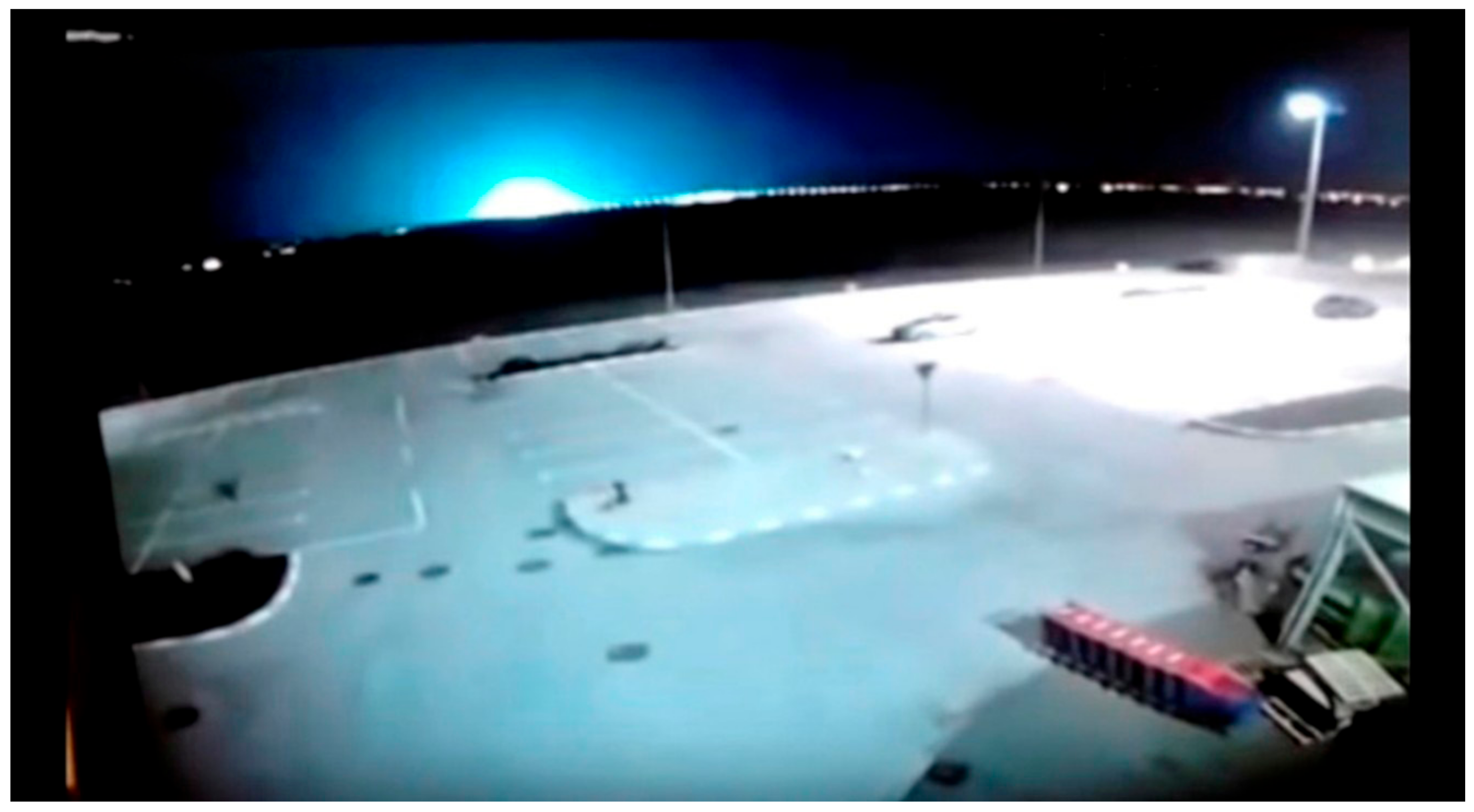
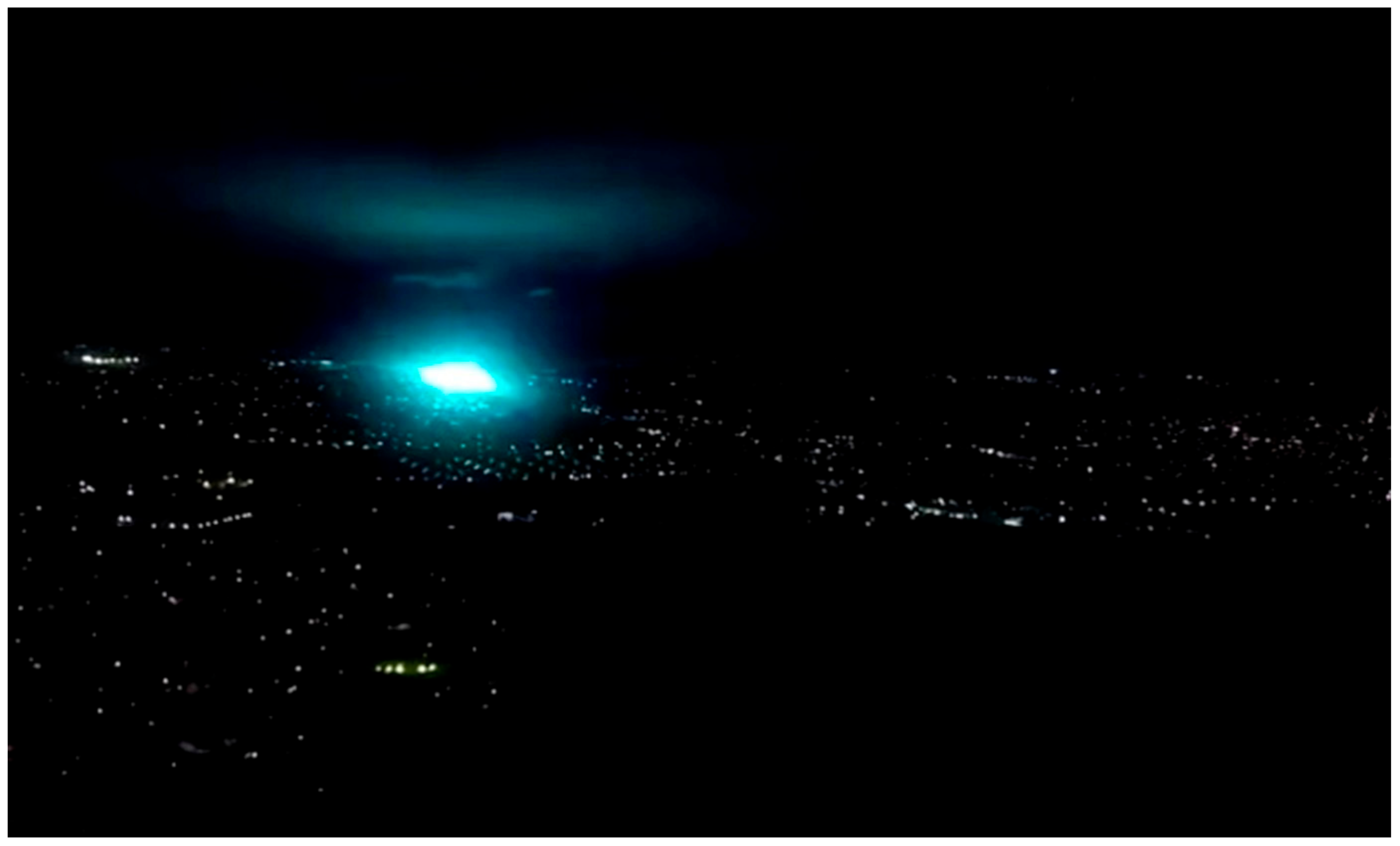
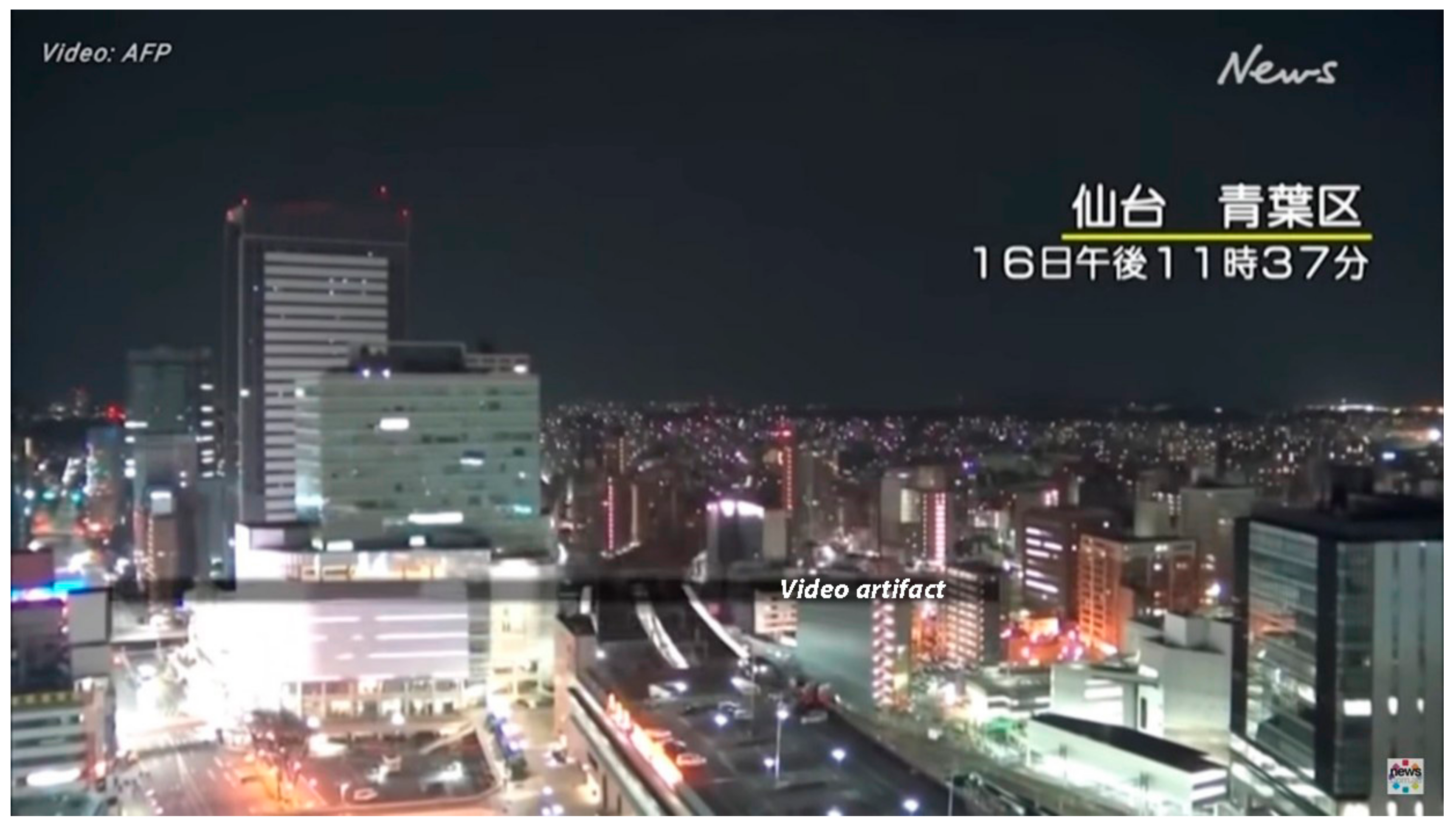
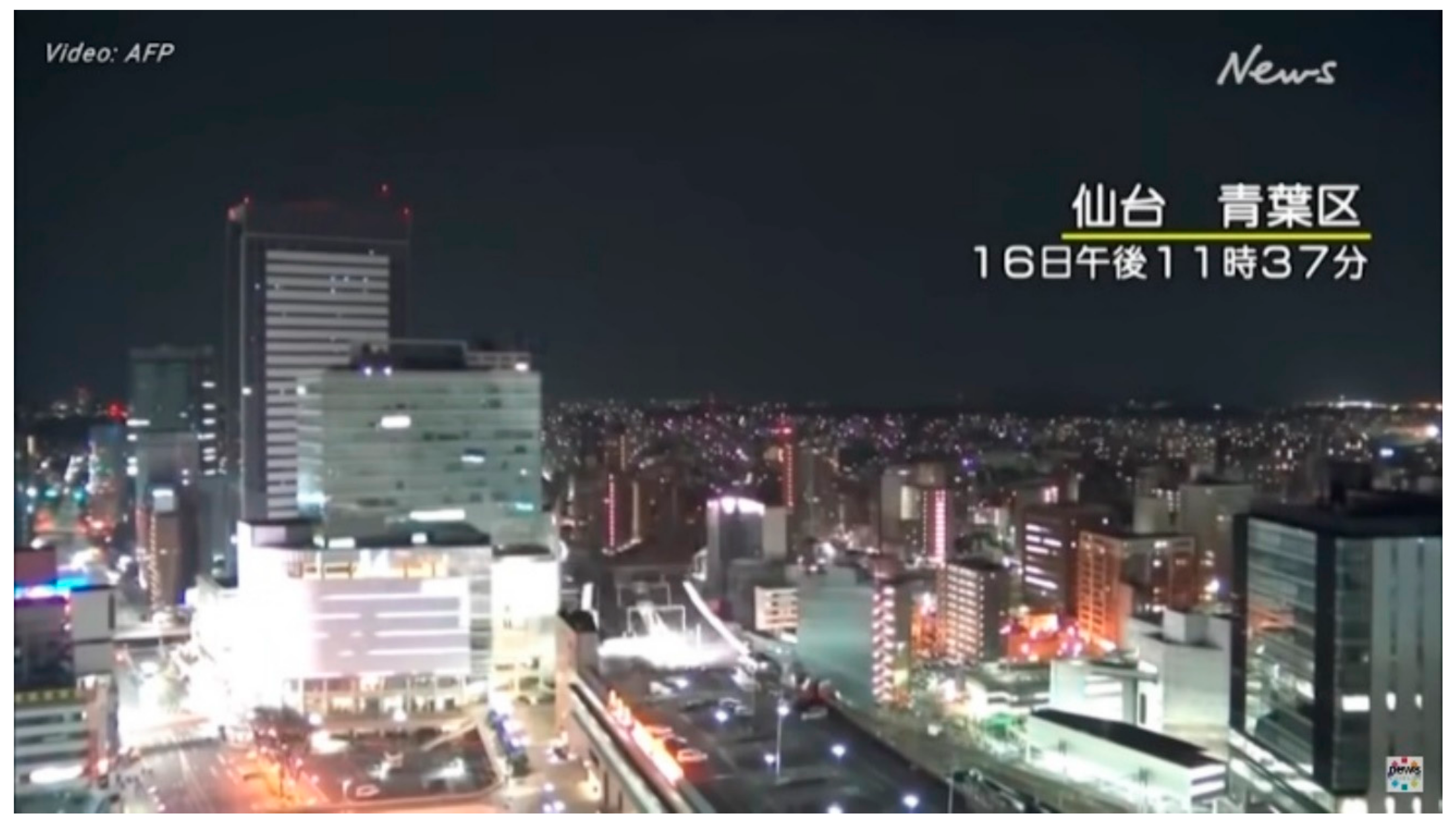
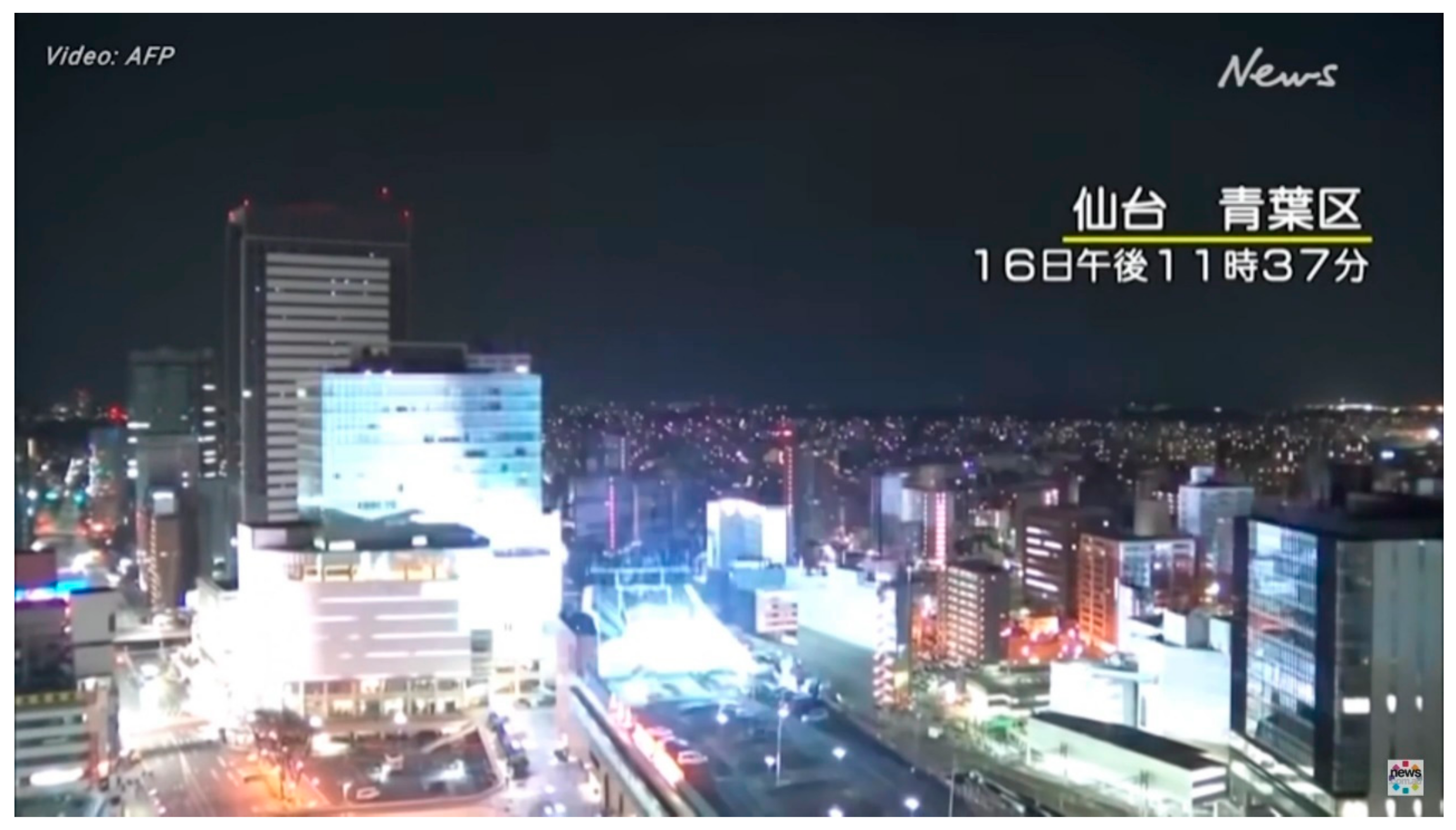
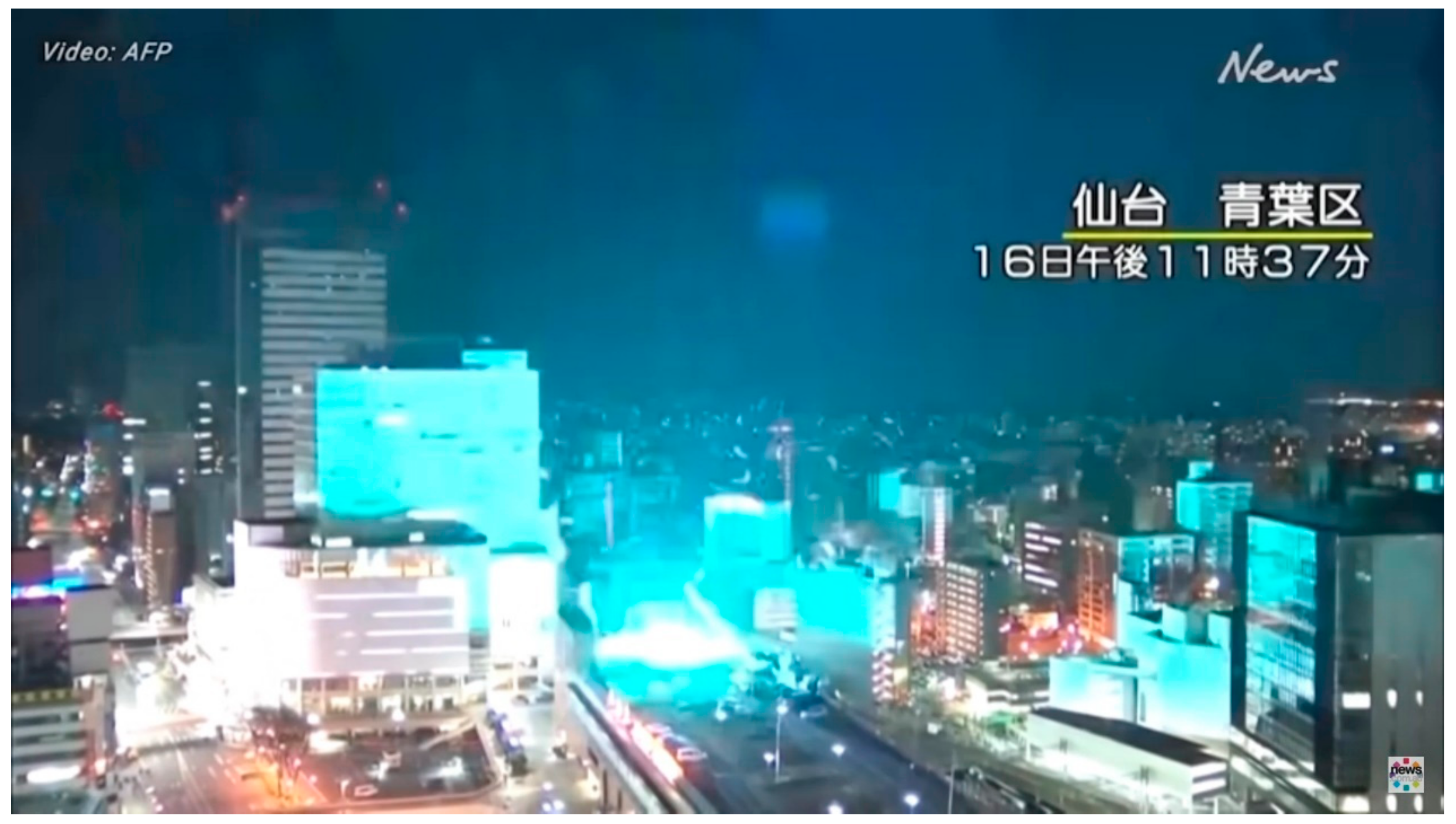
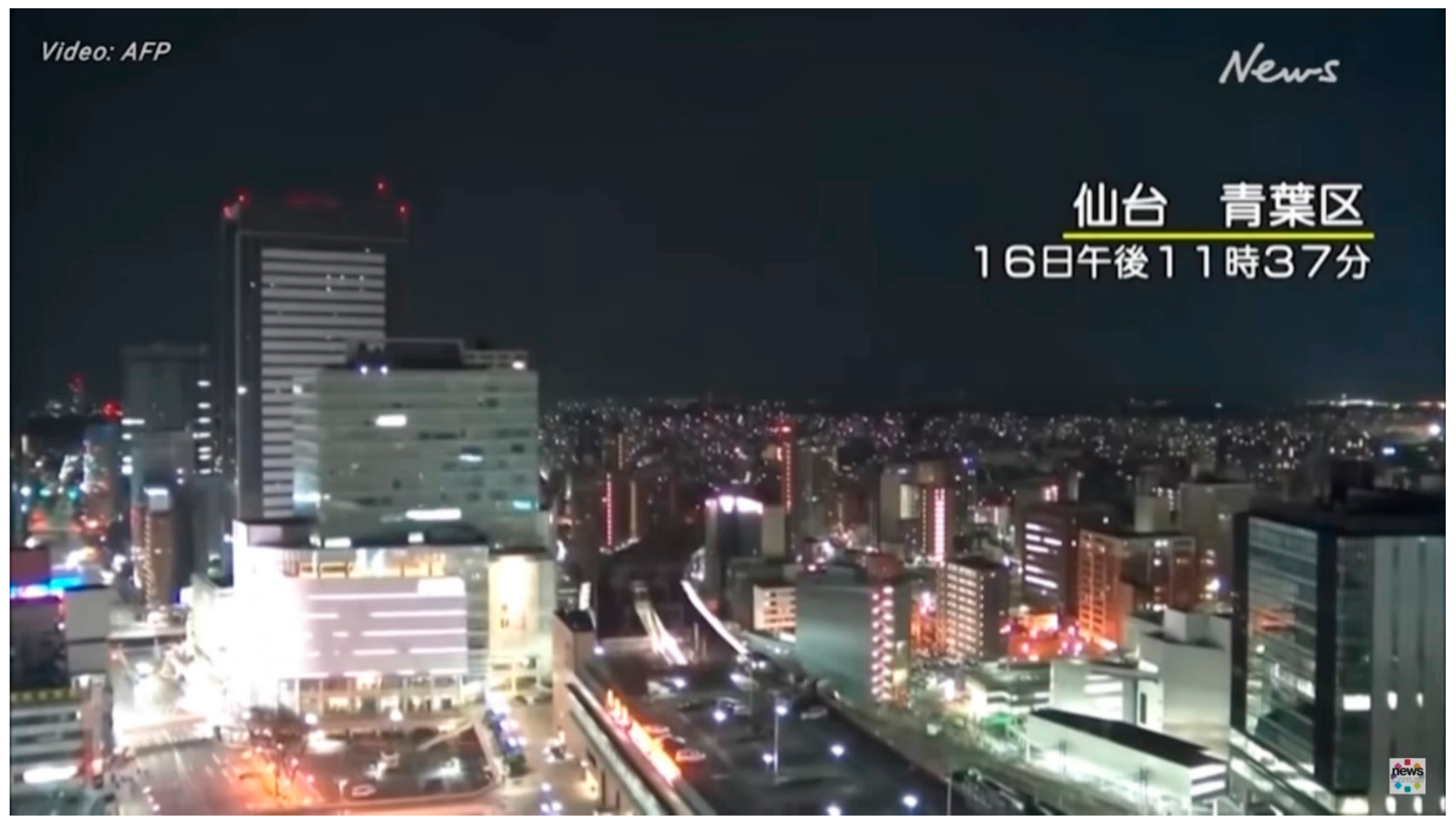
1.2. Theories on the Origin of Earthquake Light
2. Methods
2.1. The Kaikoura Earthquake
2.2. Archival Data
2.3. Videos
2.4. Interviews
3. Results
3.1. Historic Frequency
3.2. Contemporary Spatial Occurence
3.3. Wellington Area Observations
3.4. Durations of Flashes
3.5. Colour Analysis
4. Discussion
4.1. Colours
4.2. Lithology
4.3. Epicentre Distance
4.4. Faults
4.5. Possible Electricity Supply Contribution
4.6. Earthquake Light Mechanisms
4.7. Flashes in Clouds
4.8. Project Limitations
5. Conclusions
Author Contributions
Funding
Informed Consent Statement
Data Availability Statement
Acknowledgments
Conflicts of Interest
References
- Whitehead, N.; Ulusoy, Ű. Blue Sky at Midnight; Earthquake Light. Turk. J. Earth Sci. 2019, 28, 171–186. [Google Scholar] [CrossRef]
- Derr, J.S. Earthquake Lights: A Review of Observations and Present Theories. Bull. Seismol. Soc. Am. 1973, 63, 2177–2187. [Google Scholar]
- Yasui, Y. A Study on the Luminous Phenomena Accompanied with Earthquake (Part I). Mem. Kakioka Magn. Obs. 1968, 13, 25–61. [Google Scholar]
- Tsukuda, T. Sizes and Some Features of Luminous Sources Associated with the 1995 Hyogo-Ken Nambu Earthquake. J. Phys. Earth 1997, 45, 73–82. [Google Scholar] [CrossRef]
- Whitehead, N.; Ulusoy, U. New Contributions to Understanding Earthquake Light, from the 2023 Turkish Earthquakes. In Proceedings of the 7th International Conference on Earthquake Engineering and Seismology, Antalya, Türkiye, 6–10 November 2023; Eberik, M., Ed.; Springer: Berlin/Heidelberg, Germany, 2024. [Google Scholar]
- Walsh, K.J. RGB to Color Name Mapping (Triplet and Hex). Available online: https://web.njit.edu/~walsh/rgb.html (accessed on 8 September 2017).
- Petre Gameplays. Strange Blue Light in Romania During Earth Quake on 24/09/2016. Available online: https://www.youtube.com/watch?v=tctJUaC_EPg (accessed on 31 December 2021).
- Rodríguez, J. Extrañas Luces Durante El Sismo 07 de Septiembre 2017. Available online: https://www.youtube.com/watch?v=rSb9BtlqJeYunavailable2018-11-15 (accessed on 1 November 2017).
- Guardian News. “Earthquake Light” Appears in Sky Above Japanese City. Available online: https://www.youtube.com/watch?v=G8Ma0nkCqis (accessed on 17 March 2022).
- Xie, B.; Wu, L.; Mao, W.; Wang, Z.; Sun, L.; Xu, Y. Horizontal Magnetic Anomaly Accompanying the Co-Seismic Earthquake Light of the M7.3 Fukushima Earthquake of 16 March 2022: Phenomenon and Mechanism. Remote Sens. 2023, 15, 5052. [Google Scholar] [CrossRef]
- Freund, F. Charge Generation and Propagation in Igneous Rocks. J. Geodyn. 2002, 33, 543–570. [Google Scholar] [CrossRef]
- Whitehead, N.; Ulusoy, Ű. Origin of Earthquake Light Associated with Earthquakes in Christchurch, New Zealand, 2010–2011. Earth Sci. Res. J. 2015, 19, 113–119. [Google Scholar] [CrossRef]
- Ikeya, M. Earthquakes and Animals; World Scientific: Singapore, 2004; ISBN 978-981-238-591-8. [Google Scholar]
- UFO Institute. Strange Blue Lights Over Mexico City After 7.1 Earthquake (September 7, 2021). Available online: https://www.youtube.com/watch?v=zQ2xk4qB1Z4 (accessed on 20 December 2021).
- NHK. Miyagi/Sendai Earthquake Light. Available online: https://www.youtube.com/watch?v=qWzeeshG7FI (accessed on 25 September 2024).
- Whitehead, N. Flashy Geology? Geosci. Soc. N. Z. Newsl. 2018, 26, 10–12. [Google Scholar]
- Freund, F.T.; Takeuchi, A.; Lau, B.W.S. Electric Currents Streaming out of Stressed Igneous Rocks—A Step towards Understanding Pre-Earthquake Low Frequency EM Emissions. Phys. Chem. Earth Parts A/B/C 2006, 31, 389–396. [Google Scholar] [CrossRef]
- St-Laurent, F.; Derr, J.S.; Freund, F.T. Earthquake Lights and the Stress-Activation of Positive Hole Charge Carriers in Rocks. Phys. Chem. Earth Parts A/B/C 2006, 31, 305–312. [Google Scholar] [CrossRef]
- Freund, F. Pre-Earthquake Signals? Part I: Deviatoric Stresses Turn Rocks into a Source of Electric Currents. Nat. Hazards Earth Syst. Sci. 2007, 7, 535–541. [Google Scholar] [CrossRef]
- Freund, F.; Sornette, D. Electro-Magnetic Earthquake Bursts and Critical Rupture of Peroxy Bond Networks in Rocks. Tectonophysics 2007, 431, 33–47. [Google Scholar] [CrossRef]
- Freund, F.T.; Kulahci, I.G.; Cyr, G.; Ling, J.; Winnick, M.; Tregloan-Reed, J.; Freund, M.M. Air Ionization at Rock Surfaces and Pre-Earthquake Signals. J. Atmos. Sol. Terr. Phys. 2009, 71, 1824–1834. [Google Scholar] [CrossRef]
- Freund, F. Pre-Earthquake Signals: Underlying Physical Processes. J. Asian Earth Sci. 2011, 41, 383–400. [Google Scholar] [CrossRef]
- Scoville, J.; Sornette, J.; Freund, F. Paradox of Peroxy Defects and Positive Holes in Rocks. Part II: Outflow of Electric Currents from Stressed Rocks. J. Asian Earth Sci. 2015, 114, 338–351. [Google Scholar] [CrossRef]
- Takeuchi, A.; Nagahama, H. Voltage Changes Induced by Stick-Slip of Granites. Geophys. Res. Lett. 2001, 28, 3365–3368. [Google Scholar] [CrossRef]
- Takeuchi, A.; Hiroyuki, N. Interpretation of Charging on Fracture or Frictional Slip Surface of Rocks. Phys. Earth Planet. Inter. 2002, 130, 285–291. [Google Scholar] [CrossRef]
- Shinbrot, T.; Kim, N.H.; Thyagu, N.N. Electrostatic Precursors to Granular Slip Events. Proc. Natl. Acad. Sci. USA 2012, 109, 10806–10810. [Google Scholar] [CrossRef]
- Daniels, K.E.; Bauer, C.; Shinbrot, T. Correlations between Electrical and Mechanical Signals during Granular Stick-Slip Events. Granul. Matter 2014, 16, 217–222. [Google Scholar] [CrossRef]
- Mizzi, C.A.; Lin, A.Y.W.; Marks, L.D. Does Flexoelectricity Drive Triboelectricity? Phys. Rev. Lett. 2019, 123, 116103. [Google Scholar] [CrossRef]
- Li, N.; Ma, L.; Xu, X.; Luo, J. Influence of “Seebeck Effect” on Charge Transfer between Two Friction Surfaces. Tribol. Int. 2021, 161, 107060. [Google Scholar] [CrossRef]
- Mizzi, C.A.; Marks, L.D. When Flexoelectricity Drives Triboelectricity. Nano Lett. 2022, 22, 3939–3945. [Google Scholar] [CrossRef] [PubMed]
- Thomas, R.; Krehbiel, P.; Rison, W.; Edens, H.; Aulich, G.; Winn, W.; McNutt, S.; Tytgat, G.; Clark, E. Electrical Activity During the 2006 Mount St. Augustine Volcanic Eruptions. Science 2007, 315, 1097. [Google Scholar] [CrossRef] [PubMed]
- Lira, J.; Mulas, M. Time Difference Correlation between Earthquake Lights and Seismic Ground Accelerations. Appl. Geophys. 2021, 18, 9–16. [Google Scholar] [CrossRef]
- Hamling, I.; Hreinsdóttir, S.; Clark, K.; Elliott, J.; Liang, C.; Fielding, E.; Litchfield, N.; Villamor, P.; Wallace, L.; Wright, T.; et al. The Fault Rupture during 2016 Mw 7.8 Kaikōura Earthquake, New Zealand. Science 2017, 356, eaam7194. [Google Scholar] [CrossRef]
- Spewpree. 14.11.16 NZ Hanmer Springs Earthquake. Hostel CCTV. Available online: https://www.youtube.com/watch?v=YFrAZl1I5Q0 (accessed on 30 January 2018).
- Bell, Z. Earthquake Lights. Available online: https://www.youtube.com/watch?v=2yJgTnA61m8 (accessed on 31 December 2021).
- Clark, K.; Nissen, E.; Howarth, J.; Hamling, I.; Mountjoy, J.; Ries, W.; Jones, K.; Goldstien, S.; Cochran, U.; Villamor, P.; et al. Highly Variable Coastal Deformation in the 2016 MW7.8 Kaikoura Earthquake Reflects Rupture Complexity along a Transpressional Plate Boundary. Earth Planet. Sci. Lett. 2017, 474, 334–344. [Google Scholar] [CrossRef]
- Wotherspoon, L.; Palermo, A.; Holden, C. The 2016 Mw7.8 Kaikoura Earthquake: An Introduction. Bull. N. Z. Soc. Earthq. Eng. 2017, 50, i–iv. [Google Scholar] [CrossRef]
- Ballance, A. The Science Of... Earthquakes. Available online: https://www.rnz.co.nz/programmes/featured-audio/story/201823812/the-science-of-earthquakes (accessed on 30 December 2021).
- GNS Science. Magnitude 7.8, Mon Nov 14 2016 12:02 AM. Available online: http://www.geonet.org.nz/earthquake/2016p858000 (accessed on 30 December 2021).
- Beggs, J.M. Sedimentology and Paleogeography of Some Kaihikuan Torlesse Rocks in Mid Canterbury. New Zealand J. Geol. Geophys. 1980, 23, 439–445. [Google Scholar] [CrossRef]
- Time and Date. Past Weather in Wellington—November 2016. Available online: https://www.timeanddate.com/weather/new-zealand/wellington/historic?month=11&year=2016 (accessed on 7 May 2022).
- Rayleigh, L. XXXIV. On the Transmission of Light through an Atmosphere Containing Small Particles in Suspension, and on the Origin of the Blue of the Sky. Lond. Edinb. Dublin Philos. Mag. J. Sci. 1899, 47, 375–384. [Google Scholar] [CrossRef]
- Anonymous. Rayleigh Scattering. Available online: https://en.wikipedia.org/wiki/Rayleigh_scattering (accessed on 11 February 2025).
- Anonymous. Mie Scattering. Available online: https://en.wikipedia.org/wiki/Mie_scattering (accessed on 11 February 2025).
- Whitehead, N. Details of Public Comments and Videos: Earthquake Light Accompanying the Kaikoura November 2016 Earthquake. Available online: www.chchquake.co.nz (accessed on 21 December 2021).
- Gracey, D. New Zealand Earthquake—November 14, 2016. Available online: https://www.youtube.com/watch?v=GZ4JJSrQXqI (accessed on 31 December 2021).
- Nguroa. Earthquake Lights 14Nov2016—Petone Wellington. Available online: https://www.youtube.com/watch?v=WJel7bW138k&t=42s (accessed on 20 May 2022).
- MacKenzie, S. 14 Nov 2016 NZ Earthquake—Way of Life Gym & WRKA Wainui Dojo. Available online: https://www.youtube.com/watch?v=_z69O7rhUrc&t=1s (accessed on 31 December 2021).
- GNS. New Research Shows Lower Threat from Wellington Fault—18/09/2009. Available online: https://www.gns.cri.nz/Home/News-and-Events/Media-Releases/Lower-threat-from-Wellington-fault (accessed on 30 December 2021).
- United States Geological Survey. Earth Explorer. Available online: https://earthexplorer.usgs.gov/ (accessed on 3 January 2022).
- Syrian Kiwi. Sky During Earthquake in Wellington. Available online: https://www.youtube.com/watch?v=BVVm7g3QgOA (accessed on 31 December 2021).
- Young, J. 2016-11-14. 7.5 Earthquake & Earthquake Light—Wellington, New Zealand. Available online: https://www.youtube.com/watch?v=6uRjvXkRshw (accessed on 31 December 2021).
- Gyopari, M. Lower Hutt Aquifer Model Revision (HAM3): Sustainable Management of the Waiwhetu Aquifer; Greater Wellington: Wellington, New Zealand, 2014. [Google Scholar]
- Bradley, B.; Wotherspoon, L.; Kaiser, A. Ground Motion and Site Effect Observations in the Wellington Region from the 2016 Mw 7.8 Kaikoura New Zealand Earthquake. Bull. N. Z. Soc. Earthq. Eng. 2017, 50, 94–105. [Google Scholar] [CrossRef]
- Boon, D.; Perrin, N.; Dellow, G.; Van Dissen, R.; Lukovic, B. NZS1170.5:2004 Site Subsoil Classification of Lower Hutt. In Proceedings of the Ninth Pacific Conference on Earthquake Engineering Building an Earthquake-Resilient Society, Auckland, New Zealand, 14–16 April 2011; New Zealand Society for Earthquake Engineering: Wellington, New Zealand, 2011; pp. 1–8. [Google Scholar]
- Thériault, R.; St-Laurent, F.; Freund, F.T.; Derr, J.S. Prevalence of Earthquake Lights Associated with Rift Environments. Seismol. Res. Lett. 2014, 85, 159–178. [Google Scholar] [CrossRef]
- Freund, F. Co-Seismic Earthquake Lights: The Underlying Mechanism. Pure Appl. Geophys. 2019, 176, 3439–3450. [Google Scholar] [CrossRef]
- Terada, T. On Luminous Phenomena Accompanying Earthquakes. Bull. Earthq. Res. Inst. Tokyo Univ. 1931, 9, 225–255. [Google Scholar] [CrossRef][Green Version]
- Ulusoy, U.; Ikeya, M. Retrospective Statements on Unusual Phenomena before the Izmit-Turkey Earthquake (M7.4, August 17, 1999) and Their Relevance to Earthquake Forecast. In Future Systems for Earthquake Early Warning; Ulusoy, U., Kundu, H., Eds.; Nova: New York, NY, USA, 2008; pp. 3–53. ISBN 978-1-60456-795-3. [Google Scholar]
- Napier Port. Earthquake Lightning Captured at Napier Port. Available online: https://www.youtube.com/watch?v=Rd0oV7HBrZI (accessed on 31 December 2021).
- Zliper. MOMENTO EXACTO Tuxtla Gutierrez Chiapas México Terremoto 8.2 Grados 07/09/2017. Available online: https://www.youtube.com/watch?v=rLHt-0MveRs (accessed on 29 December 2021).
- Ojo Virtual. Temblor de 8.1 En Oaxaca (Vídeo Difundido). Available online: https://www.youtube.com/watch?v=fek-VxWA02U (accessed on 29 December 2021).
- Pueblaonlinevideos. Así Se Vivió El Sismo de 8.4 Grados Richter En Puebla. Available online: https://www.youtube.com/watch?v=i1zj47_pSS8 (accessed on 29 December 2021).
- Lopher, E. Momento Exacto 2 Del #TEMBLOR En Salina Cruz, Oaxaca. Available online: https://www.youtube.com/watch?v=esGYy43cB8Y (accessed on 15 November 2018).
- Soy502. Así Se Vivió El Temblor En San Marcos. Available online: https://www.youtube.com/watch?v=ULAQgdDjOzk (accessed on 29 December 2021).
- Cubrinovski, M.; Bray, J.; de la Torre, C.; Olsen, M.; Bradley, B.; Chiaro, G.; Stocks, E.; Wotherspoon, L. Liquefaction effects and associated damages observed at the Wellington Centreport from the 2016 Kaikoura earthquake. Bull. N. Z. Soc. Earthq. Eng. 2017, 50, 152–173. [Google Scholar] [CrossRef]
- Fidani, C. The Earthquake Lights (EQL) of the 6 April 2009 Aquila Earthquake, in Central Italy. Nat. Hazards Earth Syst. Sci. 2010, 10, 967–978. [Google Scholar] [CrossRef]




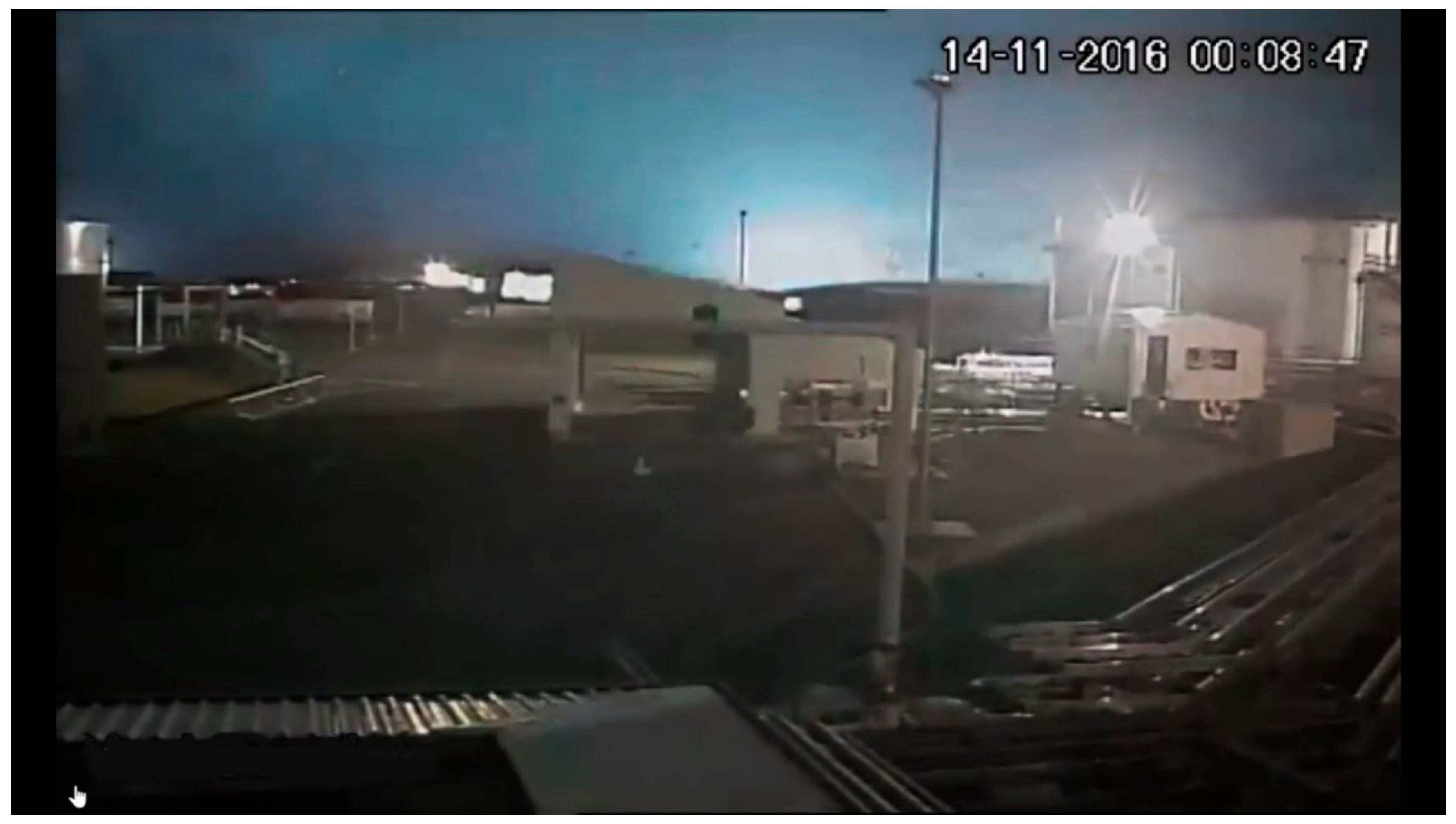


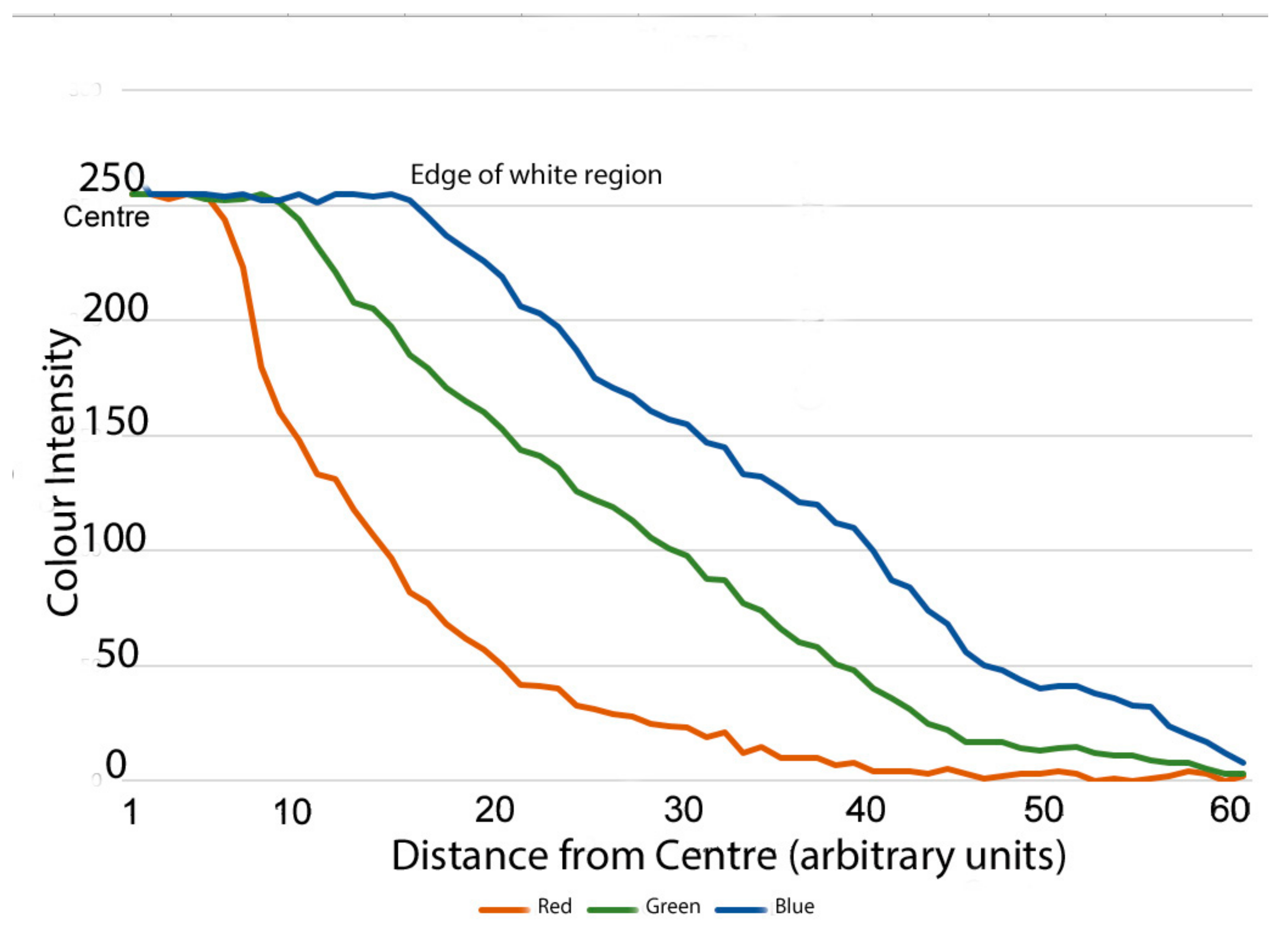

| Name | Medium | Description | Reference |
|---|---|---|---|
| Bell | Hand-held Video | Flashes above Wainuiomata hills. Reflections from clouds. | [35] |
| Gracey | Security Video | 250 m radius dome on the ground; also flashes in clouds. | [46]* |
| Nguroa | Security Video | Gracey dome; second close dome, on ground. | [47]* |
| Anonymous Observer 1 | Eyewitness | Flashes on ground, Petone | Survey |
| Anonymous Observer 2 | Eyewitness | 20 m radius flash on ground, Petone | Survey |
| Anonymous Observer 3 | Eyewitness | 2 m radius flash on ground, Taita | Survey |
| Anonymous Observer 4 | Eyewitness | Flash on Wainuiomata fault trace | Survey |
| McKenzie | Security Video | Cloud flashes, Wainuiomata | [48] |
| Anonymous Observer 5 | Eyewitness | Flash in Wainuiomata cloud | Survey |
| Anonymous Observer 6 | Eyewitness | Flashes from the sea, Westport | Survey |
| EQ Light Location | Earthquake Year | Magnitude | Epicentre Distance (km) | Reference |
|---|---|---|---|---|
| USA New Madrid, | 1811 | Mw7.5 | 600 | [56] |
| Turkey Izmit, | 1999 | Mw7.8 | 260 | [59] |
| New Zealand Napier, | 2016 | Mw7.8 | 540 | [60]* |
| Whangarei, | 2016 | Mw7.8 | 800 | Eyewitness [35] |
| Kerikeri, Mexico | 2016 | Mw7.8 | 900 | Eyewitness |
| Mexico City | 2017 | Mw8.2 | 650 | [14] |
| Mexico City | 2021 | Mw7.1 | 380 | [14]*. |
Disclaimer/Publisher’s Note: The statements, opinions and data contained in all publications are solely those of the individual author(s) and contributor(s) and not of MDPI and/or the editor(s). MDPI and/or the editor(s) disclaim responsibility for any injury to people or property resulting from any ideas, methods, instructions or products referred to in the content. |
© 2025 by the authors. Licensee MDPI, Basel, Switzerland. This article is an open access article distributed under the terms and conditions of the Creative Commons Attribution (CC BY) license (https://creativecommons.org/licenses/by/4.0/).
Share and Cite
Whitehead, N.E.; Ulusoy, U. New Insights into Earthquake Light: Rayleigh Scattering as the Source of Blue Hue and a Novel Co-Seismic Cloud Phenomenon. Atmosphere 2025, 16, 277. https://doi.org/10.3390/atmos16030277
Whitehead NE, Ulusoy U. New Insights into Earthquake Light: Rayleigh Scattering as the Source of Blue Hue and a Novel Co-Seismic Cloud Phenomenon. Atmosphere. 2025; 16(3):277. https://doi.org/10.3390/atmos16030277
Chicago/Turabian StyleWhitehead, Neil Evan, and Ulku Ulusoy. 2025. "New Insights into Earthquake Light: Rayleigh Scattering as the Source of Blue Hue and a Novel Co-Seismic Cloud Phenomenon" Atmosphere 16, no. 3: 277. https://doi.org/10.3390/atmos16030277
APA StyleWhitehead, N. E., & Ulusoy, U. (2025). New Insights into Earthquake Light: Rayleigh Scattering as the Source of Blue Hue and a Novel Co-Seismic Cloud Phenomenon. Atmosphere, 16(3), 277. https://doi.org/10.3390/atmos16030277






